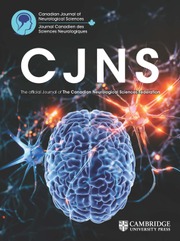No CrossRef data available.
Article contents
Movement Disorders in Central Nervous System Tuberculosis: A Systematic Review
Published online by Cambridge University Press: 29 September 2025
Abstract
Tuberculosis (TB) affecting the central nervous system (CNS) can lead to a broad range of movement disorders, which are frequently overlooked in clinical settings. This review explores the various presentations, underlying mechanisms and patient outcomes related to these disorders.
We systematically reviewed published case reports, series and cohort studies that described patients with CNS TB who developed movement disorders. Extracted data included patient characteristics, type of CNS TB, imaging and CSF findings, types of movement disorders, treatments used and outcomes.
A total of 61 patients with CNS TB and associated movement disorders were analyzed. The most common manifestations were ataxia, dystonia, chorea or hemiballismus and parkinsonism. Less frequent symptoms included opsoclonus-myoclonus, segmental myoclonus, tremors, cervical dystonia and stereotypy. TB meningitis was the predominant form, often accompanied by infarcts, hydrocephalus or tuberculomas. Proposed causes included vascular injury, inflammatory lesions, immune mechanisms and drug-related effects. All patients received anti-tuberculosis treatment, and nearly half required corticosteroids or surgical procedures. About 25 patients (41%) fully recovered, 17 (27.9%) had significant improvement, 13 (21.3%) showed partial improvement, 11 (18.0%) had ongoing problems and 1 (1.6%) died. Cohort studies also reveal that movement disorders – particularly tremors, dystonia, parkinsonism and ataxia – are frequent but underrecognized in CNS TB. These typically emerge early, often within three weeks, and are linked to lesions in the basal ganglia or thalamus.
Movement disorders in CNS TB are more common than generally recognized. Prompt diagnosis through imaging and timely therapy can greatly improve neurological outcomes.
Résumé
Troubles du mouvement dans la tuberculose du système nerveux central : résultats d’une revue systématique.
La tuberculose (TB) du système nerveux central (SNC) peut se manifester par un large éventail de troubles du mouvement qui, bien souvent, passent inaperçus en clinique. La revue visait à relever les différentes manifestations de la maladie, les mécanismes sous-jacents et l’état de santé des patients en lien avec ces troubles.
L’équipe a procédé à un examen systématique d’exposés de cas, de séries et d’études de cohortes publiés, portant sur des patients atteints de la TB du SNC qui présentaient des troubles du mouvement. Les données extraites comprenaient les caractéristiques des patients, le type de TB du SNC, les résultats des examens par imagerie et des analyses du liquide céphalorachidien, les types de troubles du mouvement, les traitements et les résultats obtenus.
Au total, les dossiers de 61 patients atteints de TB du SNC qui présentaient des troubles du mouvement associés à la maladie ont fait l’objet d’analyse. Les manifestations les plus fréquentes étaient l’ataxie, la dystonie, la chorée ou l’hémiballisme et le syndrome parkinsonien. Des symptômes moins fréquents comprenaient l’opsoclonie-myoclonie, la myoclonie segmentaire, les tremblements, la dystonie cervicale et la stéréotypie. La forme la plus courante était la méningite tuberculeuse, qui s’accompagnait souvent d’infarctus, d’hydrocéphalie ou de tuberculomes. Parmi les causes envisagées, il y avait les lésions vasculaires, les lésions inflammatoires, les mécanismes immunitaires et les effets de certains médicaments. Les patients ont tous été soumis à un traitement antituberculeux, et presque la moitié d’entre eux ont dû recevoir des corticostéroïdes ou être opérés. Environ 25 patients (41 %) ont connu un rétablissement complet; 17 (27, 9 %), une amélioration importante de leur état et 13 (21,3 %), une amélioration partielle; 11 (18,0 %) ont fait face à problèmes persistants, et 1 (1,6 %) est mort. En outre, d’après les études de cohorte, les troubles du mouvement, notamment les tremblements, la dystonie, le syndrome parkinsonien et l’ataxie, sont fréquents, mais ils passent inaperçus dans la TB du SNC. Ces troubles apparaissent généralement tôt, souvent au cours des trois premières semaines de la maladie, et ils sont liés à des lésions des noyaux gris centraux ou du thalamus.
Les troubles du mouvement dans la TB du SNC sont plus fréquents que ne le laisse croire, en général, leur reconnaissance. Ainsi, la pose rapide d’un diagnostic par l’imagerie et la mise en route d’un traitement en temps opportun peuvent améliorer grandement les résultats neurologiques.
Information
- Type
- Original Article
- Information
- Copyright
- © The Author(s), 2025. Published by Cambridge University Press on behalf of Canadian Neurological Sciences Federation

